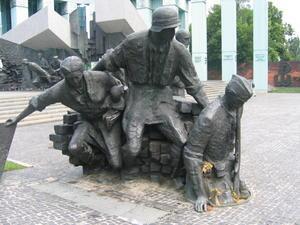Advertisement
Published: August 8th 2006

 1
1
Monument honouring the thousands of civilians who took part in the Warsaw Uprising in August 1944. Note woman and child. Man on right is going down a sewer opening. The insurgents ran through Warsaw's sewers to deliver weapons to other parts of the city.Hello everybody,
Every country in Europe has their story about WWII. From the neutral--Sweden, to the "try to stay neutral"--Norway and Holland, to the participants--England. No country suffered more devastation than Poland.
On September 1, Hitler's army invaded Poland without having declared war. Seventeen days later the Soviet Red Army attacked from the east. The Poles found out much later that a secret agreement was in place between the two countries to split Poland. Water and hydro was cut off. The were bombed everyday for four weeks. The Polish Army was no match for Germany's army. As France and England stood by, Warsaw was forced to capitulate having been promised honourable treatment. Warsaw was especially important for its operational potential. The plan was to turn Warsaw into a German town. The plans also called for reducing the city area by twenty times to seven square kilometres and reducing the population ten times to 130,000 people. Poles, who were merely slaves were forced to live in a separate district.
Another part of the overall plan was to build the Warsaw Ghetto to house the city's 350,000 Jews. When the Jewish population was reduced to 50,000, the first uprising took

 2
2
Thousands of children took part in the Home Army. This train engine was hollow for carrying messages. Kids also cleaned rifles and helped put out fires.place in April 1943. Using homemade weapons and guns that had been supplied by the underground, the remaining occupants of the Ghetto fought back. Seven thousand died in combat--many with guns in their hands. Many more died under falling buildings. Twenty thousand found shelter outside the ghetto.
The Home Army was formed shortly after Poland capitulated in 1939. They performed many important functions leading to the uprising in 1944. They destroyed German equipment and tools, burned warehouses, destroyed railroads, operated printing presses and killed several hundred German soldiers, officers and dignitaries. They were also good at getting money from their invader. Their final action was was to stage a final uprising in August, 1944. The 30-50,000 soldiers had been trained by the underground. They were under-armed. They got no help from the Red Army. It was to Russia's advantage for Warsaw to fall. During the 63-day uprising, 18,000 died, 12,000 wounded, plus 130-180 civilians lost their lives--including many children. 500,000 remaining civilians were expelled from Warsaw until January 1945 when the Soviets "liberated" them. During the uprising the Germans lost 17,000 men and 9,000 were injured. I chatted with a young high school teacher in the train between Warsaw

 3
3
Monument is called "The Little Insurgent." Boy Scouts and Girl Guides were responsible for recruiting and training children for the uprising. Imagine a 12 year old boy receiving the Medal of Valour for heroism.and Krakow. She told me that her grandmother (now 85) had carried a gun for the underground. She was shot in the leg by the Germans during the uprising. Many years later her father spent seven months in a Soviet jail.
After the Soviets "liberated" Poland, many of the members of the Home Army were sent to Siberia in case they got any more ideas about an independant Poland.
The Uprising Museum I visited in Warsaw is one of the best museums that I have taken in. It is only one-third complete. One part was thirty or so metres of "sewer" that you could walk through. To imagine that people ran through the sewer system for miles, especially in the dark.
The pictures tell more of the story.
Bye for now,
Donna
Advertisement
Tot: 0.299s; Tpl: 0.015s; cc: 10; qc: 57; dbt: 0.0738s; 1; m:domysql w:travelblog (10.17.0.13); sld: 1;
; mem: 1.1mb

 1
1
 2
2
 3
3




